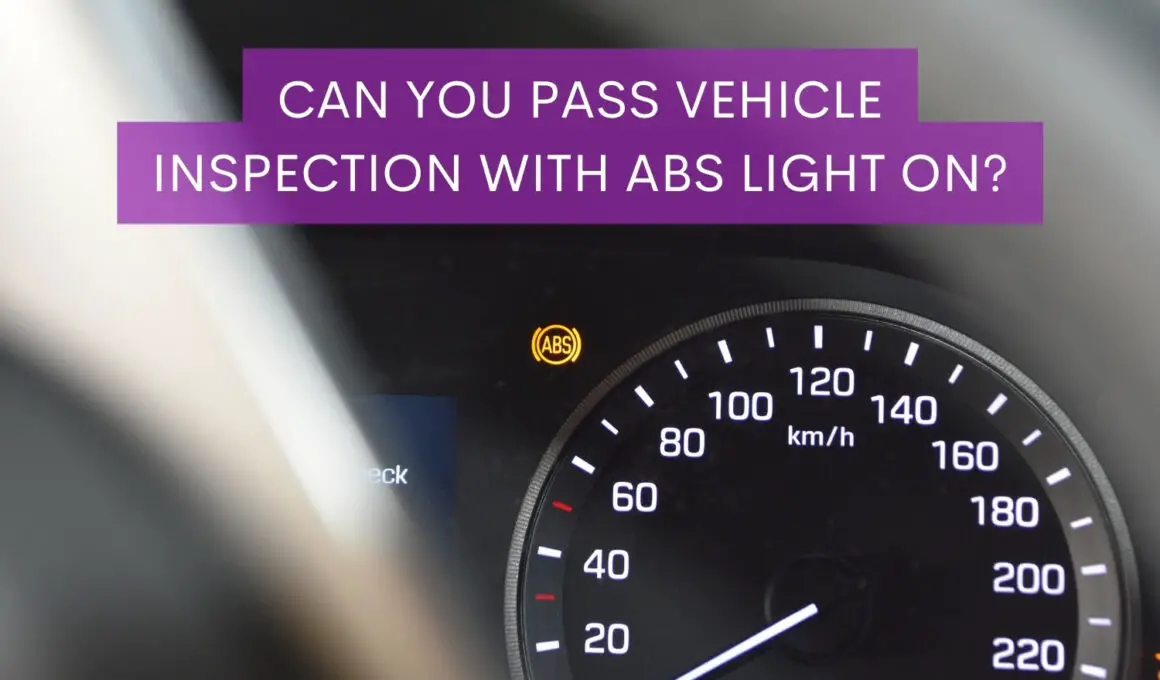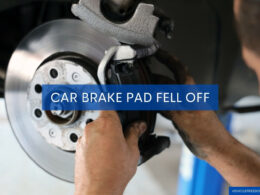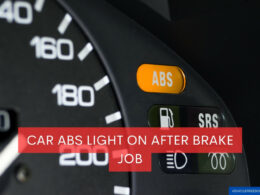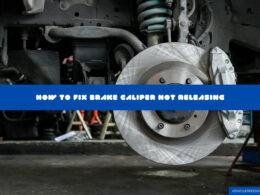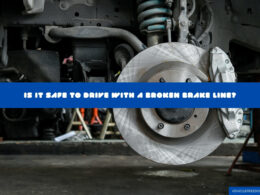In This Article Show
Every vehicle owner understands the occasional pit-in-the-stomach feeling when a light on the dashboard flicks on. It could signal a minor glitch or a major issue, but one thing’s for sure – it demands your attention. One such warning light that often leaves drivers wondering is the ABS (Anti-lock Braking System) light.
The ABS is a crucial safety feature in modern vehicles, designed to prevent your brakes from locking up and causing uncontrolled skidding. Therefore, it’s a component you can’t afford to overlook. But what does it mean when the ABS light is on, and more importantly, can your vehicle still pass an inspection with this warning sign?
In this comprehensive guide, we’ll explore the intricacies of the ABS light, its implications on vehicle inspections, and practical steps to take if this little warning appears.
Whether you’re a seasoned driver or a beginner, this blog will equip you with the knowledge you need about the ABS light and its role in vehicle inspections.
Understanding the ABS Light
The ABS light is part of your vehicle’s onboard diagnostic system, specifically designed to monitor the health of the Anti-lock Braking System. When functioning properly, the ABS enhances vehicle safety by allowing drivers to maintain steering control during an emergency stop or when braking on slippery surfaces.
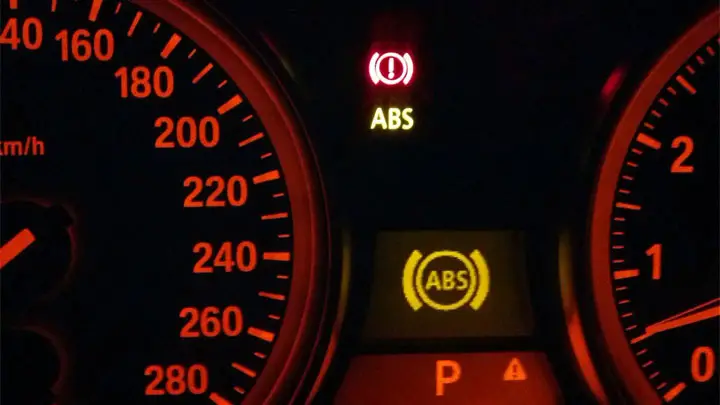
Meaning of the ABS Light
When the ABS light is illuminated, it is indicating a potential issue within the anti-lock braking system. This does not necessarily mean the vehicle’s main braking system is compromised. Instead, the issue is likely specific to the additional ABS components.
This light is essentially your vehicle’s way of saying, “Hey, something’s not quite right with the ABS. You might want to get that checked out.”
Importance of ABS in Vehicle Safety
The Anti-lock Braking System is a key safety feature. It is designed to prevent your brakes from locking up when you stop abruptly. Doing so helps you maintain control over the steering, potentially averting dangerous skids, especially on slippery surfaces.
Without a fully functional ABS, your vehicle could be at a higher risk of accidents during emergency braking situations.
Common Reasons Why the ABS Light Comes On
Several issues can trigger the ABS light. These range from low brake fluid levels and blown fuses to more serious concerns like malfunctioning wheel sensors or issues with the hydraulic pump or valves.
Each of these could impact the effectiveness of the anti-lock braking system, signaling the need for immediate attention.
The Impact of ABS Light on Vehicle Inspections
Just as the ABS light is an essential aspect of your vehicle’s safety systems, vehicle inspections are critical in ensuring that all cars on the road meet certain safety and environmental standards. But how does the ABS light factor into these inspections?
General Impact of Warning Lights on Vehicle Inspections
During a vehicle inspection, all warning lights are scrutinized. These lights are designed to indicate issues that may affect the vehicle’s safety or emission levels. Therefore, any illuminated warning light, including the ABS light, could potentially be a cause for concern during an inspection.
Specific Implications of an ABS Light On During Inspection
When it comes to the ABS light specifically, its impact on the outcome of a vehicle inspection can vary depending on local regulations. Some jurisdictions consider the ABS as an essential safety feature so that an illuminated ABS light could result in a failed inspection.
On the other hand, some regions may focus more on emission controls and primary brake function, and may pass a vehicle even if the ABS light is on, provided all other systems meet their standards.
Variations in Vehicle Inspection Standards Across States
In the United States, vehicle inspection regulations vary from state to state. Some states have comprehensive safety inspections, including a thorough check of the vehicle’s braking system, including the ABS.
Others may not have as stringent safety inspections and may focus more on emissions testing.
Therefore, the impact of an ABS light during an inspection can largely depend on your location and the specific inspection criteria applied.
Steps to Take When Your ABS Light is On
It’s natural to feel a twinge of concern when a dashboard warning light comes on. But don’t panic—there are logical steps you can follow to address the issue.
1. Initial Steps: Checking for Obvious Issues
When the ABS light first illuminates, a good starting point is to check for any apparent issues. This could be as simple as ensuring your car is fully turned on, as some lights may briefly appear when the vehicle is in the ‘on’ position but not fully started.
If the light remains, checking your brake fluid level can be helpful, as low fluid can sometimes trigger the ABS light.
2. Professional Diagnosis: When to Involve a Mechanic
If the ABS light remains on after these initial checks, it’s time to bring in a professional.
A certified mechanic or auto technician can run a diagnostic test to identify the exact cause of the problem. This could be a malfunctioning ABS sensor, an issue with the hydraulic system, or other potential concerns.
3. Repairing and Resetting Your ABS System
Once the issue is identified, the mechanic can then undertake necessary repairs to fix the problem and reset the ABS light. Depending on the severity of the problem, this could range from replacing a sensor to more significant work.
Regardless, addressing the issue promptly is crucial for passing your vehicle inspection and maintaining your vehicle’s safety.
Tips to Prepare Your Vehicle for Inspection
Vehicle inspections can be a breeze if you take proactive measures to ensure your vehicle is in top condition. With a focus on ABS, here are some tips to help you prepare for your next inspection:
1. Pre-Inspection Checklist
Before your inspection, it can be helpful to conduct a pre-inspection check. Check all lights, including headlights, brake lights, and dashboard warning lights like the ABS light. Make sure your tires are in good condition, and all fluids are at the correct level, including brake fluid, which can affect the ABS.
2. Addressing ABS Issues Before an Inspection
If your ABS light is on, addressing this before your inspection is crucial. This includes getting a professional diagnosis and carrying out the necessary repairs. Not only can this help you pass your vehicle inspection, but it also ensures your vehicle is safe to drive.
3. Maintaining Your Vehicle’s ABS System Regularly
Routine maintenance of your vehicle’s ABS system is vital. Regular checks can help spot and rectify potential issues before they become significant problems. Maintenance might include brake fluid checks and replacements, sensor checks, and professional servicing of the braking system.
Wrapping it up
The importance of the ABS light in vehicle inspections cannot be overstated. As we’ve explored in this article, an illuminated ABS light warns that there’s an issue with your Anti-lock Braking System.
This isn’t something you should overlook, as the ABS is a crucial element of your vehicle’s safety features.
While the impact of an ABS light on a vehicle inspection can vary depending on local regulations, it’s always advisable to address any warning lights before an inspection.
Not only does this increase your chances of passing the inspection, but it also ensures your vehicle maintains its performance and safety standards, thereby providing you peace of mind on the road.






